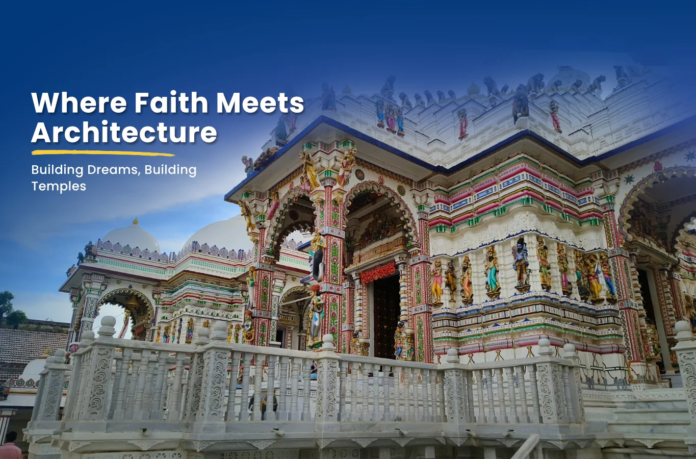Jain temples are architectural masterpieces that combine intricate artistry with profound symbolism. Each element of a Jain temple serves a spiritual purpose, reflecting the values and teachings of Jain philosophy. Guided by the expertise of a Temple Architect in India, these sacred spaces represent a union of devotion, art, and meticulous craftsmanship. The contributions of Jain Temple Sompura artisans and temple construction services in Rajasthan play a significant role in creating and preserving these intricate structures.
The Role of Art and Symbolism in Jain Temples
Art in Jain temples is not merely decorative; it serves to:
- Convey Spiritual Teachings: Through symbolic motifs and carvings.
- Inspire Devotion: By creating an environment of tranquility and sanctity.
- Preserve History: Through depictions of religious narratives and historical events.
Key Elements of Art in Jain Temple Design
1. Intricate Carvings
Depictions of Tirthankaras
The walls, pillars, and ceilings of Jain temples are adorned with carvings of Tirthankaras (spiritual teachers). These figures symbolize purity, enlightenment, and liberation.
Floral and Geometric Patterns
Floral motifs and geometric patterns are prominent in Jain temples, representing the infinite nature of the universe and the cycle of life.
2. Sculptural Masterpieces
Idols in the Sanctum Sanctorum
The idols of Tirthankaras in the sanctum are central to Jain temple design. These idols are often crafted from marble or precious metals, symbolizing purity and serenity.
Celestial Figures and Mythological Stories
Carvings of celestial beings, apsaras, and mythological narratives adorn the temple, showcasing the rich artistic tradition of Jain culture.
3. Decorative Ceilings and Domes
Chandrasalas and Mandalas
Ceilings often feature Chandrasalas (semi-circular arches) and Mandalas (geometric designs) that symbolize cosmic harmony and spirituality.
Sculpted Domes in Jain Temples
Domes, particularly in Rajasthan, are richly carved with layers of intricate designs, representing the connection between the earthly and the divine.
4. Pillars of Symmetry
Symbol of Eternity
The meticulously carved pillars in Jain temples symbolize strength, eternity, and the unwavering path to enlightenment.
Alignment and Proportions
Pillars are arranged symmetrically, reflecting the Jain emphasis on balance and order in life.
Symbolism in Jain Temple Architecture
1. Temple Layout and Mandala Design
Sacred Geometry
The temple’s layout is based on the Mandala, representing the cosmos and the journey towards liberation (Moksha). The central sanctum, or Garbha Griha, symbolizes the soul’s purity.
Cardinal Directions
Temples are aligned with the cardinal directions, reflecting the Jain belief in universal balance.
2. The Shikharas (Spire)
Reaching Towards the Divine
The Shikhara, or spire, represents the soul’s ascent towards liberation. Its towering height inspires devotion and humility.
Design Variations in Rajasthan
In Rajasthan, temple construction services incorporate intricate stonework and unique shapes in Shikharas, making them distinctive landmarks.
3. Symbolic Use of Materials
Marble and Sandstone
The use of marble in Jain temples symbolizes purity, while sandstone reflects strength and endurance. These materials are abundant in Rajasthan, making it a hub for Jain temple construction.
Precious Inlays
Temples often feature inlays of precious stones and metals, symbolizing spiritual wealth and devotion.
4. Ritualistic Spaces
Garbha Griha (Sanctum Sanctorum)
The sanctum sanctorum represents the innermost core of the soul, housing the idol of the Tirthankara. Its design is simple yet profoundly spiritual.
Circumambulatory Pathways
The pathways around the sanctum allow devotees to perform Pradakshina (circumambulation), symbolizing reverence and surrender to the divine.
The Role of Temple Architects and Artisans
Temple Architect in India
Mastery of Symbolism
A temple architect in India combines artistic creativity with deep knowledge of Jain philosophy to design temples that reflect spiritual ideals.
Preserving Ancient Techniques
By integrating traditional methods with modern technology, architects ensure the art and symbolism in Jain temples remain timeless.
Sompura Artisans and Their Legacy
Expert Craftsmanship
The Jain temple Sompura artisans are renowned for their unparalleled skill in carving intricate designs and maintaining the spiritual essence of temple art.
Prominent Contributions
Famous Jain temples, such as the Dilwara Temples in Mount Abu and the Ranakpur Temple, are testaments to the Sompura artisans’ expertise.
Temple Construction Services in Rajasthan
Integration of Tradition and Innovation
Temple construction services in Rajasthan specialize in creating temples that adhere to traditional designs while incorporating modern structural techniques.
Focus on Local Artistry
These services work closely with local artisans, ensuring that the region’s unique architectural style and materials are celebrated.
Challenges in Preserving Art and Symbolism
1. Erosion and Aging
The intricate carvings in historical Jain temples are vulnerable to erosion and weathering, particularly in regions like Rajasthan.
2. Shortage of Skilled Artisans
The dwindling number of skilled artisans poses a significant challenge to preserving traditional temple art.
3. Balancing Modern Needs
Integrating modern amenities, such as lighting and accessibility features, without compromising artistic integrity can be difficult.
Solutions for Preserving Jain Temple Art
1. Digital Documentation
Using tools like 3D scanning to document existing art ensures accurate restoration when needed.
2. Training the Next Generation
Establishing training programs for artisans helps preserve the traditional skills of the Sompura community.
3. Sustainable Practices
Incorporating eco-friendly materials and techniques aligns with Jain values while ensuring durability.
Conclusion
Art and symbolism in Jain temple design are a profound reflection of spiritual philosophy and architectural brilliance. The expertise of a temple architect in India, supported by the craftsmanship of Jain temple Sompura artisans and the efficiency of Temple Construction Service in Rajasthan, ensures that these sacred spaces continue to inspire devotion and awe.
By preserving and celebrating the art and symbolism in Jain temples, India safeguards a timeless heritage that unites spirituality, culture, and artistry for generations to come.



